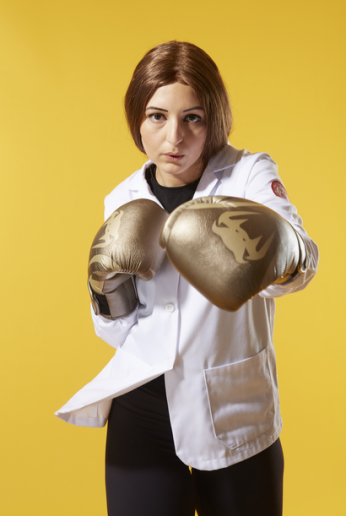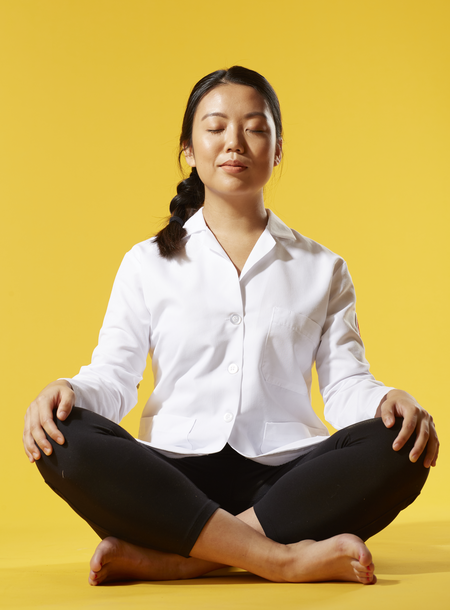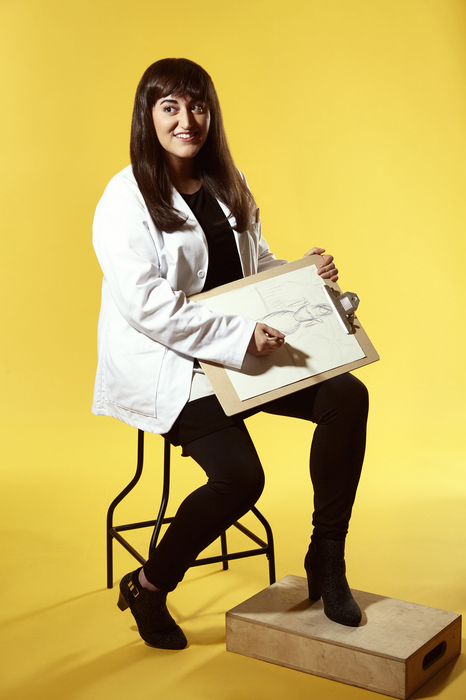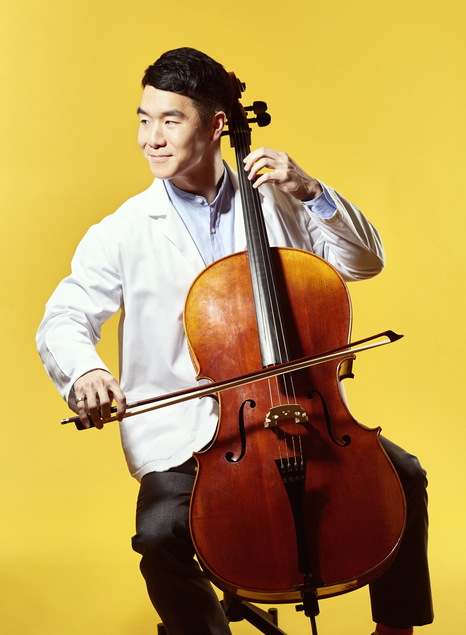By Beth Saulnier
Photos by Stephanie Diani
When Dr. Sandeep “Sunny” Kishore, PhD ’12, MD ’14, gave the commencement speech for the Class of 2014, he stood onstage in Carnegie Hall and confessed something: as a third-year medical student, he’d initially failed his surgical “shelf” exam, one of the rigorous tests given after each core rotation. Having resumed his MD studies after a lauded five years as a doctoral candidate and a postdoctoral fellow at Harvard Medical School—which included winning a national award for outstanding graduate student in microbiology and working with the United Nations on non-communicable disease policy—Dr. Kishore had found the return to medical school surprisingly tough, and he took the failure hard. “The interesting thing is how I dealt with it,” recalls Dr. Kishore, now an assistant professor of health system design and global health at the Icahn School of Medicine at Mount Sinai, where he is associate director of the Arnhold Institute for Global Health. In a medical culture steeped in self-sacrifice and machismo, he says, “I didn’t seek anyone to talk to about it, and I didn’t tell my colleagues. I was ashamed. I couldn’t embrace vulnerability.”

Stephanie Azzopardi, MD-PhD student - “For stress relief, I engage in cardio kickboxing about five times a week. It’s a fun, intense workout that has become a huge part of my lifestyle."
Sensing that there was a life lesson in his experience, Dr. Kishore shared what had been a painful secret with the audience in the iconic concert hall. The response afterward blew him away. “It became clear that there were many people who had also felt isolated and exhausted at times, but didn’t have an outlet for it—that burnout was very real,” says Dr. Kishore, who is now a member of the steering committee of the National Academy of Medicine’s Action Collaborative on Clinician Well-Being and Resilience. “We were all like ducks with our feet paddling under the water, but above it we had to show that we were cool and calm. I failed the surgery shelf exam—but the real issue is that I didn’t feel comfortable opening up, seeking support and breaking a culture of silence.”
Dr. Kishore’s experience reflects a perennial problem. But today, with growing awareness that aspects of medical school and physician practice can contribute to burnout, academic medical centers are cultivating an emerging—if still embryonic—commitment to improved wellbeing and resilience among students and doctors. Part of that includes tentative first steps to better discern the causes of burnout, particularly in students. But as medical educators and administrators work to create an environment to improve student wellbeing and resilience, they are simultaneously integrating stress reduction into curricula and student life. “It is a privilege to care for patients, and both their joys and suffering give us a profound sense of purpose as physicians,” says Dr. Augustine M.K. Choi, the Suzanne and Stephen Weiss Dean of Weill Cornell Medicine. “But the ways both medical education and healthcare delivery are structured can erode doctors’ and medical students’ sense of meaning. It is imperative that we do all we can to nurture the motivators that bring medical students and physicians into medicine to maximize their wellbeing and our patients’ care.”

Aaron Chen ’21 - “To manage stress, I love playing basketball with my classmates in Olin Gym. It allows me to experience healthy competition and get in a great workout in the process.”
Just how burned out are doctors? One group estimates that the phenomenon is experienced by 30 to 40 percent of physicians, according to a 2009 study published in The Lancet. In a commentary in JAMA in 2011, Dr. Liselotte Dyrbye and Dr. Tait Shanafelt—two pioneering researchers in the field—wrote that “preliminary evidence suggests that excessive workloads (e.g., work hours, on-call responsibilities), subsequent difficulty balancing personal and professional life, and deteriorating work control, autonomy, and meaning in work contribute to burnout in physicians.” But the number of doctors affected is hard to quantify. This September, a JAMA article described a systematic review of 182 studies on the subject—and concluded that because there was so much variability in how burnout was defined, assessed and queried, the rate could be anywhere from zero to 80.5 percent of doctors. “Burnout is a buzzword that’s been in the news, but what is it? How does it affect doctors and their patients?” an NPR story wondered. “It turns out, nobody really knows.”
The academic literature on medical student burnout is similarly emerging. Still, researchers have found that students report symptoms of anxiety and depression, and are trying to understand why they may be at increased risk. Medical students are likely to experience symptoms of depression more often than peers in the general population, according to a 2016 meta-analysis published in JAMA. Another JAMA study, published this year, found that elevated anxiety in medical school—along with being female, having children and training in certain specialties—correlates with symptoms of burnout in residency. Still, it is not clear whether the prevalence of depression and anxiety is comparable to that found in students enrolled in other types of professional schools.

Dora Chen ’22 - “I like to cook and bake. It helps with my mental health by allowing me to get focused on the flow of the activity and take a mental break from the stressors in my life.”
Dr. Choi wants Weill Cornell Medicine to take a leadership role in working with medical school educators and professional entities to better understand the nature of burnout and its implications for students and doctors. “Burnout has been a longstanding problem in the medical profession, and its origins are complex,” says Dr. Barbara Hempstead, senior associate dean for education. “It is so very important that it is being recognized in the student, resident and faculty populations, and we have a lot of work to do to tackle this. Medical schools around the country are examining the learning environment—including the role played by curricula, standardized testing, competition among peers and the transition to residency—to better understand burnout and make changes to help the system be more supportive for students, residents and physicians.”
In the meantime, initiatives to combat stress and burnout have been launched at a variety of levels at Weill Cornell Medicine, from student life to the curriculum to individual clinical departments. Students can avail themselves of such free offerings as yoga classes, chair massages, guided meditation sessions and social hours each Wednesday morning. Well at Weill, a program for medical and grad students, offers events such as a popular monthly lecture and hosts a website that’s a one-stop resource on wellness from several angles—physical, intellectual, emotional, spiritual and more.
Dr. Alice Tang, assistant professor of clinical medicine, has been interested in issues of burnout since her residency at NYU, where she introduced stress management and resiliency training as chief resident. She notes that although she graduated from medical school only six years ago, open discussion of such issues has come a long way. “Back then, burnout was almost conceptualized as for people who are weak and can’t cope, so if you’re burned out it’s your fault,” says Dr. Tang, who lectures to Weill Cornell Medicine first-years about the different manifestations of stress. “We’re lucky that there’s now so much in the media and the medical journals showing that this is a systemic issue.”
Another reason why student wellness has become a more prominent topic in recent years involves a generational shift: millennials are generally more willing to ask for help and to avail themselves of the support services they came to expect as undergrads. “They’re a different generation than we were,” says Dr. Dana Zappetti, assistant professor of medicine and associate dean for student affairs, who earned her MD in 1999. “Our students want to talk about stress and issues surrounding mental health and self-care. They are motivated to ask hard questions about how physicians and trainees work, and how self-care and wellbeing can be integrated and accepted into a culture that has traditionally been built upon self-sacrifice.”
Yet because burnout—and, conversely, wellness—have been so widely discussed among students and trainees, “it has opened the door for faculty to talk about it as well,” says Dr. Klaus Kjaer, chief quality and patient safety officer for the Weill Cornell Physician Organization. Still, he says, “More senior faculty come from a generation where it was important not to show any weakness. It will take time to change that culture. At the same time, many faculty will be relieved that we are finally starting to talk about this.”
Cultivating Mentally Healthy Medical Students

Joanna Gao ’20 - “I may not be the best yogi, but I always turn to yoga during stressful periods in my life. I love that you have to focus all of your energy into holding your pose, and therefore clear away your other stressors.”
For the past several years at Weill Cornell Medicine, sessions on wellness have been included in student orientation, with similar offerings at times of transition, such as before clerkship and residency. According to Dr. Zappetti, the aim is to ground first-years in the realities of med school life—and to reassure them that they’re not alone. “Even though they’re successful, motivated, hardworking students, many get overwhelmed,” Dr. Zappetti says. “For one thing, they’re used to being the best and the brightest, and now they’re surrounded by the best and the brightest. And the volume of material is enormous, so that you really can’t even miss a day.” Dr. Zappetti talks to incoming students about burnout and offers strategies for combatting it—including common-sense advice like getting proper sleep, exercising, eating right and maintaining outside relationships. “There’s this old concept that medicine requires a lot of self-sacrifice,” she observes. “People sometimes think they should be all in to medicine and nothing else. That idea is changing, but there still is a bit of it.”

Danny Kramer, MD-PhD student - “Most of my fun reading is non-medical. On my bedside, I currently have Out of Africa, Future Shock, and a murder mystery called Hope Never Dies.”
Orientation includes appearances by the directors of Student Health Services (Dr. Edgar Figueroa, MD ’00, associate professor of family medicine in clinical medicine) and Student Mental Health Services (Dr. Richard Friedman, professor of clinical psychiatry), who encourage students to seek them out. Says Dr. Friedman: “I ask them, ‘How many of you went to college in New York City?’ and very few hands go up. And I say, ‘Most of you left your close friends and social network behind, so it’s natural to feel stressed and lonely.’” Dr. Figueroa’s role entails being the primary care physician for the medical and grad students who don’t already have one—and to urge students to take the advice they will likely preach when they are physicians, to maintain a balanced and healthy lifestyle. “When I first see a student, I ask, ‘What do you do for fun?’” Dr. Figueroa says. “I use that as an opening to discuss the fact that you need outside interests, whether it’s to prevent burnout or keep some self-motivation going. If you enjoy rock climbing, for example, there are ways to keep doing that.”
One of the biggest gains in student mental health services at Weill Cornell Medicine has been the hiring of a part-time clinician to provide talk therapy to students; this addition reinforces the idea that seeking help is nothing to be ashamed of, Dr. Zappetti says. Social worker Amy Miranda started in the position last February, seeing Weill Cornell Medicine students about a day and a half per week. She soon found herself in high demand, as students sought counseling for issues like academic stress and relationship problems—so much so that a second therapist has been hired. “Especially for medical students, the biggest challenge is fitting an appointment into a busy day,” Miranda observes. “There are so many requirements for their time, and they may be reluctant to ask for an hour off to come to a therapy session.”
Other efforts aim to train doctors to have life-long habits of self-care—to be compassionate and empathic to themselves as well as to others, and to enjoy their own lives so they can give their patients the best care possible. Innovations include a program in which second-years mentor first-years, as well as two new student government positions: medical and graduate students each have an elected wellness representative who serves as a liaison to the administration. Yili Zhao, MD ’21, filled that role for medical students in 2017–18; last year’s graduate student representative was Shana Bergman, a doctoral candidate in physiology, biophysics and systems biology. Zhao—whose favorite ways of blowing off steam are doing yoga and going thrift-shopping—calls Miranda’s hiring an “amazing” improvement. And Bergman, who’s an avid weightlifter, notes that for her and many other students, exercise remains a tried-and-true method of stress relief. “Anything that gives you a physical outlet for your emotional stress is very helpful,” she says. “Whether it’s a yoga club or the dodgeball team, physical activity is one of the best ways that I and other people deal with it.”
Promoting Physician Wellness
While the incidence and causes of burnout may not be well understood, few would argue that it doesn’t exist. And as many concerned with clinician wellness have noted, it’s not just about protecting doctors; it’s also a patient care issue. Dr. Lucy Willis, assistant professor of clinical emergency medicine, compares it to the safety lecture on airplanes: in an emergency, put on your own oxygen mask before helping others. “You have to take care of yourself in order to take care of other people,” she says. “How you feel impacts patient care—therefore, it’s in everyone’s best interest to address it.” Dr. Dyrbye and Dr. Shanafelt, the longtime researchers on physician burnout nationwide, stressed that point in their JAMA commentary. “Physicians who have burnout are more likely to report making recent medical errors, score lower on instruments measuring empathy, and plan to retire early and have higher job dissatisfaction,” they wrote, “which has been associated with reduced patient satisfaction with medical care and patient adherence to treatment plans.”

Brienne Lubor ’21 - “I love drawing as a stress-reducing activity. When I have free time, I like to explore the city and bring my sketchbook to new places I visit.”
Among the Weill Cornell Medicine departments at the forefront of promoting wellness and resilience to deal with the stresses of patient care is emergency medicine. As Dr. Willis notes, the issue hits the ED particularly hard: surveys have repeatedly found emergency medicine—in which practitioners often face high patient volumes and work in fast-paced conditions—to have the highest burnout rate of any specialty. Launched about two years ago, the ED’s wellness program includes ways for improving the department’s sense of community, including regular social outings; it has also hosted lectures on topics like “second-victim syndrome,” a form of PTSD that can strike clinicians who treat traumatic cases. But the biggest gains, Dr. Willis says, have come from some work place changes. The ED renovated its breakroom from a chaotic space into a calmer one, complete with massage chair; it instituted formal breaks, so staff have protected time to eat or use the bathroom. And in what Dr. Willis says was the biggest quality-of-life boost, it hired scribes to free clinical staff from some of their paperwork burden. “Scribes and breaks have made my job so much more pleasant,” says Dr. Willis, adding that surveys taken before and after the changes have shown an uptick in morale. “And having an administration that’s willing to listen, to make changes based on what the front-line physicians need—that has been very helpful.”

Timothy Kim ’19 - “I’ve been playing cello for seventeen years. I play in a quartet regularly, as well as in orchestras here and there. Mostly, I practice on my own to relieve stress.
Similarly, the Department of Anesthesiology has been promoting wellness among its faculty and trainees for nearly a decade. The issue has been incorporated into the residency’s educational program, which includes lectures on topics like mindfulness, nutrition and sleep hygiene. “Building community has been critical,” says Dr. Eric Brumberger, director of the anesthesiology residency program, noting that in the last few years the Accreditation Council for Graduate Medical Education mandated that residencies include a wellness component. “Residents and medical students are at one of the most challenging times in their lives, not only in terms of stress, but they’re at an age when most mental illnesses present in the general population. It’s a very at-risk time.
The department has created “sibling” programs to match new trainees with more experienced peers. It has also established a residency support council that weighs in on the wellness curriculum and organizes social events, like a monthly outing to a local watering hole, an annual barbecue, softball games and more. Like the ED, anesthesiology has administered surveys to assess progress. “There has been measurable improvement in terms of morale,” says Dr. Brumberger, noting that the department recently established a similar council for faculty. “The residents report feeling supported and knowing that they have a safe space and people who care about them.”
Among Dr. Kjaer’s responsibilities at the Physician Organization is looking at the relationship between provider wellness and clinical outcomes; the organization is now making preliminary plans for a student and faculty survey in early 2019. “We would like to get a baseline assessment,” says Dr. Kjaer, who is also an associate professor of clinical anesthesiology. “We are interested in seeing at a more granular level what patterns might exist. Are there certain populations among our faculty that may be more vulnerable—such as particular specialties, academic ranks, age groups or practice locations?”
This story first appeared in Weill Cornell Medicine, Fall 2018

